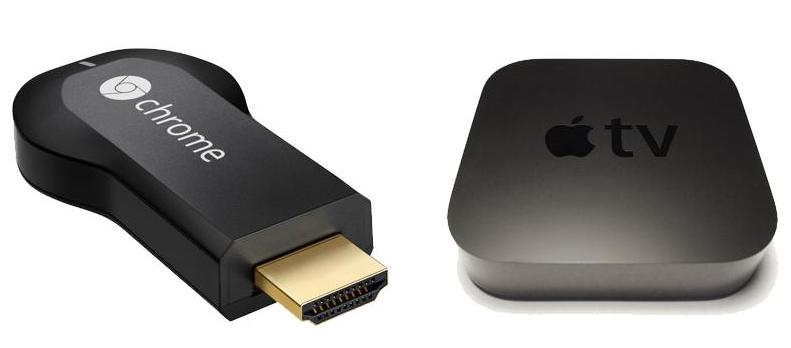The new Apple TV distinguishes itself from Google’s Chromecast and previous versions of the Apple TV by adding support for independently developed apps and games. Just like Apple’s iPhone, iPad, and Apple Watch, the Apple TV now has a dedicated app store. Apart from the preinstalled iTunes app, the new Apple TV requires the user to install apps for each TV content provider, such as HBO or CBS.

Chromecast needs an app from each content provider too, but these run on a separate device (it supports Windows, Mac, Android, and iOS devices) that connects to Chromecast over Wi-Fi and casts the video content onto the TV screen. When a video stream is initiated from a provider, it is sent over the network, without the device relaying the stream. It also means your mobile device or PC will be free to use for other purposes, and all that streaming won’t eat up the device’s battery power.
There are a couple of exceptions, however. Games played on mobile devices cast to the TV have to render game graphics and can’t be decoupled from the Chromecast. Moreover, playing local content on a device through the browser can’t be disconnected either.
Size and setup
The industrial-looking, black-colored Apple TV is relatively heavy (about the weight of a hockey puck) due to the A8 Processor and minimum of 32GB of memory to support its app-centric design requires a big power supply.
In contrast, the Chromecast is a small, bright-colored, plastic disk that weighs almost nothing and is designed to do just one thing -render video and audio streams over Wi-Fi on a TV. There’s no room on it for additional apps, just enough memory to buffer incoming video from other devices.
The physical setup for new Apple TV and chromecast 2 is simple -plug an HDMI cable into the display, and plug into a power source. Apple simplifies setup by transferring Wi-Fi, iTunes, iCloud, and Game Center login credentials to an iPhone within close proximity of the Apple TV.
Pros and cons of Apple TV’s new Siri Remote
Another very noticeable physical difference is the new Siri Remote that controls the Apple TV. It combines a touchpad with volume, play/pause, menu, and Siri buttons for the device. The 1.5-square-inch track pad on the remote controls gestures across the TV screen. The massive difference between this tiny track pad and the large TV screen (about a 50:1 remote-to-display ratio in my tests on a 60-inch TV) made swiping erratic and choppy.
Entering login credentials on the Apple TV, which was required for every content app that isn’t provided by Apple, is downright awkward. Surprisingly, Apple hasn’t built an iOS app to perform Siri Remote functions on the 4th-gen Apple TV. Previous versions of the Apple TV were compatible with the Remote app, which provided a keyboard on an iOS device for search and for typing login credentials.
With the new Apple TV, you have to hunt and peck on a TV screen and enter each letter of each user name and password. The Siri Remote has a microphone that could be used in place of the Remote to search for content, but for now you’re limited to the hunt-and-peck method to enter login credentials.
Chromecast supports Windows, Mac, iOS, and Android devices. While Chromecast also requires a different login for each content provider, you can at least use a PC, smartphone, or tablet to enter the information with a full keyboard.
Universal search
Apple and Google both enable users to search for content across both their own and independent services, which benefits both companies greatly.
Both services offer voice search that will browse through your existing subscriptions and return all the viewing options. Searching for Breaking Bad, for example, will return the option to stream episodes on Netflix and Amazon Prime video (if you subscribe to and download apps for both), or to purchase episodes on Google Play or iTunes.
As the top-level search index, Apple and Google both get a chance to sell content with each search, which will be a much bigger business than selling the streaming devices.
Compatibility with PCs
Google and Apple don’t emphasize that both streaming devices work with computers, too. Apple TV will only work with other Apple devices, using AirPlay to mirror the computer screen or iOS screen to your Apple TV. Chromecast will work with any Chrome extension-compatible browser on either a computer or a mobile device.
Pricing
The Apple TV costs $149 for the 32GB version and $199 for a 64GB version. The Chromecast costs just $35, and right now you can get two Chromecasts for just $55.
Further Reading:
Play Netflix Movies and TV Shows on Apple TV 4/3/2/1
Tips and Guide for HD Video Streaming with Apple TV
Keep My iTunes Rentals Forever on Apple TV
Stream Music, Video and Movies from iTunes library to Apple TV 4
Watch Media on New Apple TV: iTunes Home Sharing VS Plex
How to Set up 2015 4th Generation Apple TV?
Fix Apple TV Wi-Fi, AirPlay, Remote, Video, Audio Playback Issues
Set Up Apple TV Using an iPhone, iPad, or Bluetooth Keyboard